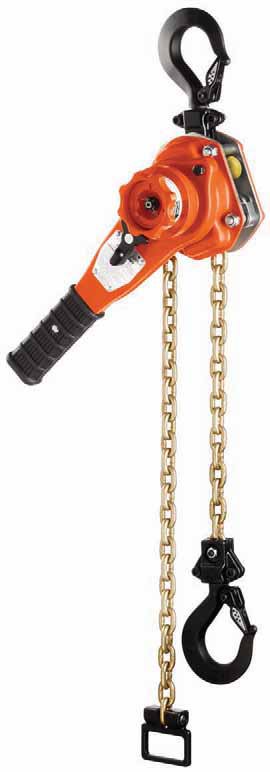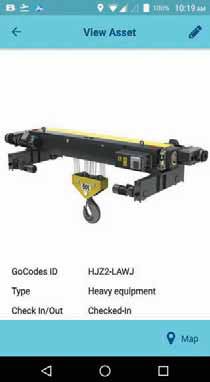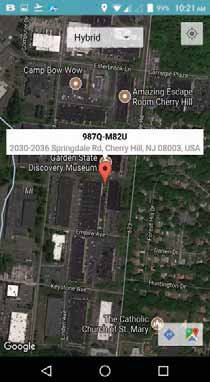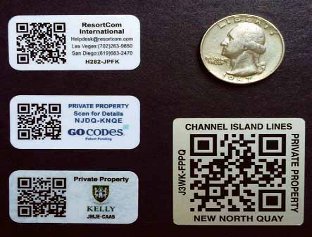Smart tracking
27 April 2018A company with many tools needs to keep track of where they are and what they have done. Changes have come in tagging technology, and more are on their way. We look at developments in asset tracking technology.
Asset tracking has many uses in many industries. In the hoist and lifting industry, one use is paramount: monitoring the state of equipment. Lifting heavy objects inherently carries risk. For that reason hoists, hooks, ropes and the rest must be in good condition; it is a statutory requirement in many markets that they are regularly inspected or tested at regular, specified intervals, and that they are certified as such. Keeping track of when any particular hook or hoist, out of several dozen that could be issued from the warehouse for a particular job on a particular day, was last inspected can be a major administrative task. It takes time, and people, and therefore costs money.
The dawn of cheap digitalisation has simplified the task. A digital tag attached to or embedded in each piece of equipment can identify it with certainty. It can be scanned by a hand-held device, and can be electronically linked with a complete record of its past useage and current status.
Hitherto RFID—Radio Frequency Identification—has been the technology of choice for tagging in the lifting industry. It has advantages: the tag is compact and one tag can store up to 2KB of data, which allows stronger encoded identification. It has disadvantages also. RFID tags contain miniaturised antennas and use radio waves to communicate with the scanner. Metal surfaces reflect radio-waves and liquids do also; so when attached to metal, in particular to large metal objects such as cranes, and in wet conditions, the signal can become unreadable.
Other technologies are available. They range from magnetic strips to barcodes to QR systems, each suited to different industries and applications.
“There are quite a few older solutions out there,” says Todd Penney of Go- Codes, manufacturers of tracking software. “But even these are early in the adoption-by-market process. You would think that tracking would be either enshrined in regulation or best practice but lots of data is still hand-written or on a spread-sheet.
“Even big multi-nationals call in sheepishly saying that now they want something decent in place.” In safetyrelated equipment Penney says that he finds this almost scary.
The major development, however, is in the devices that read the tags. Hitherto the norm has been to use dedicated scanning devices. The movement now is to using smartphones or tablets as scanners, via apps that are downloaded on to them.
Penney explains the advantages. “Using smartphones or tablets as the scanner is a real development. Dedicated scanners can cost $3,000 each. They are wonderful technology but they do add considerably to costs—especially since every team supervisor would need one.
“But everyone is walking around with their own personal very powerful sensor and camera in their pockets. Harness that, and provide your software as an app, and you are using equipment that is not a dedicated company device. And you can transmit and store your data on the cloud—yet another advantage. “We provide tagging and ID as well as cloud and app-based software,” says Penney. “The tags themselves are of anodised aluminium, rigid, about 1.5in (3cm) square, attached with very strong 3M adhesive to the item of kit. The ID on the tag is patented QR code technology, that can be scanned by smartphone from one to two feet away.” QR—the square black-and-white maze patterns that are becoming ubiquitous in many areas—has advantages over RFID. “RFID is problematic because you cannot attach it directly to metal,” says Penney. “QR is visual and code-based, so that issue is sidestepped. The other great advantage of QR is that it is fault tolerant. You may need to clean the tag to read it, but we know that in the real world splashes of paint, oil, grime and mud do happen and the tag is going to get dirty. But QR has a lot of redundancy built in. It can sustain 30% loss. As long as around 70% of the tag remains in reasonable condition, it remains readable.”
The tag identifies the item. The app logs, via smartphone, every transaction that it undergoes.
“Date, time, a photograph, service, warranty information; it can link to an inspection checklist. It can even calculate financial depreciation and add that in. It really is designed to help you manage that piece of kit throughout its lifecycle from procurement to selling or scrapping 10 or 15 years later. It is all about keeping good information about that item.
“QR codes alone have no GPS tracking capability, but if they are scanned with a smartphone it is possible to associate the location of the smartphone with the location of the QR code and hence to know exactly where the asset was when it was scanned,” says Penney.
Set-up has become easier. “We provide tagging and ID as well as cloud and app-based software. We understand that our customers don’t want to wrestle with setting up the software—they just want a buy-and-use system. So we customise, ship, and set up the software for our clients. The customer gets all that from a single vendor. That is how we come to market—as a single source for tracking,” says Penney.”
In some applications, however, RFID is still appropriate and the technology of choice. Taiwan-based Yoke has been manufacturing lifting components— hoists, hooks and lifting points—and fall-protection harnesses for 30 years. An emphasised selling point is that individual forged parts and cap screws are traceable to Test Certification.
“We install RFID chips into products that are used for overhead lifting,” says Yoke’s Sheila Lin. “We define ‘overhead’ as anything above 1.2m, because any drop over that height can damage the goods and risk human injury.
“To perform a safe lift users must ensure that all components are certified and also safe” she says. “To help end users be confident when they pick up an item from the warehouse that it is fit to go and certified we install tracking devices in them—an RFID chip.
“The chip is very tiny—around 4mm in diameter—and is fixed to the lifting points that we sell.”
Yoke offers either a dedicated scanner or a smart-phone system.
Using the smartphone as reader, if a 20t object needs to be lifted the cellphone scans each lifting point. “You are able to see that this product has been inspected and what the result was,” says Lin. “If it is good to go it shows a green light. If it has not been inspected recently enough, or failed the inspection, the light is red and you cannot proceed.
“The NFC technology for the app on the cell-phone is already open-source,” she says.
NFC is an evolution from RFID. It stands for Near-Field Communication and allows phones, tablets, and laptops to transfer and share data such as video, contact information, and photos.
The advantages of smart-phone and app-based scanning we have discussed. Lin gives a reason why some users might want to stick with the dedicated reader. “Industries with confidentiality issues wouldn’t want cellphones carried around. So they use dedicated scanners to read the text, sort it, and send it for download to a computer.”
Yoke supplies hoist equipment to military users, who would be one obvious candidate for that option.
“Masterlink is our other product line that uses RFID,” says Lin. “Below the hoist hook everything depends on the slings and that link. So a hangtag with RFID goes along with it, is assembled with the sling. Users can scan it each time the sling is used and every time it comes back to see the status of the item.”
So that’s the technology—but what of the deeper benefits of asset tracking? Safety benefits and financial benefits go hand in hand. Tom Bamford of InfoChip explains: “In the ten years that I have been involved in this the genesis of trying to track things was always two-fold: firstly, safety compliance, and secondly, inventory management.
“It is easy to see that safety and accountability are increased with a digital tracking system. But there is also pure efficiency in it. It saves time and dollars. “The lowest hanging fruit in pushing digitalised tracking is the financial one. Companies are always going to say ‘We are safe already’. But in fact digital identification of pieces or kit, whether it is done by RFID, or even by old-fashioned barcode, makes the company safer.
“The reality is that a company may have a dozen hoists and two dozen hooks for them, and who knows how many slings; and let’s face it, after nine months in the field all hoists look the same.
“So the team needs to know which particular hoist they are using, out of the dozen or more in the warehouse. Countersunk into a hoist that information can be embedded. The numbers don’t get scrambled, as they might if they were copied down from a printed tag hanging from part of the hoist; they cannot get obscured by mud or partially painted over; and, more importantly, the team leader can read the numbers on his smartphone.” Bamford is messianic about smartphone app technology. And here we enter the realms of Industry 4.0 and what Big Data can do.
“The app itself is the heart of the system’s utility,” he says. “It does more than identify the item of kit. Once you know which particular item you have in your hand, many things follow. “In pre-digital days the working load limit for that piece of kit would have been buried somewhere in a filing cabinet at head office. Now it is there on the app, for the guy in the field to see. And this has consequences. For one thing, it drives not just maintenance but predictive maintenance and failure prediction.
“Because every owner of a hoist or its associated kit uses it in his own environment and set of conditions. You may be on the north slope of Alaska, or in the North Sea, or in the South Texas desert. You want to know how long your hoist will last, so that you can predict pull-out and replacement dates. The handbook or the vendor says, ‘Oh, it will last five years’—but was that in temperate conditions, or cold or hot ones, or sandblasted ones or what? You want to know how long it will last for you.
“That question is answerable if you can report on its history. With digital asset tracking and the item chipped, after six months or so you can begin to accumulate the data that will tell you. You can look at the digital reports and analyse them. “We are getting into the realms of Big Data here. Thousands of points of information allow you to analyse safety and useage—and abusage. And this leads to predictive safety—and to the savings in dollars and cents.
“Questions like, ‘Which teams are using the equipment most responsibly? Which teams are overloading it, who is burning through the equipment, losing it, mishandling it?’ can be answered now. Big data analyses that and tells you. “And the minute you start tracking and checking with the app, the users will know, and will change their behaviour. It is the Big Brother effect. They become less sloppy.”
Which Penney echoes: “Identification is the key. Let everyone know that you have a tracking device and telemetry data and you get a chain of accountability that was not there before.”
Bamford says: “I deal a lot with companies in the overhead power line marketplace. They have hoists; they have crews who lose or break things. As soon as they chip their equipment the metric is immediate: a reduction in loss and damage. The chip says, ‘Someone is aware of what you are doing’. So everyone becomes more careful and conscientious. The metric analytics kick in after six months: you need that amount of historical data.”
Recording data is not all that the chip and app can do. “Here is a showcase application: the app emails the right people, and their supervisor, with a list of items that are due or overdue for inspection or certification. And if the warehouse does not send a replacement for the item while it is away being certified, it can email an alert notification to everyone there as well to prompt them to stay on top of the game.”
Lin at Yoke agrees: “The app offers management of the asset,” she says. “Whenever it is activated it shows the date it was last activated, and the next scheduled inspection date. A default alarm every six months can say ‘inspect this item.’
“Different items need inspection according to different schedules and to different national regulations. The app contains a digest of the regulations, summarised into six questions. The user answers Y (Yes) or N (No). He can also input numbers, for example the age of the product, the load it has been carrying, and cycles of loading and unloading. Our system makes the calculations and gives guidance as to whether the item is still useable.” Above even that, says Bamford, is a whole new level of tracking app-led sophistication, and one that may prove a game-changer:
“You can have a re-order app. The user flags if an item breaks, or the app flags when it is due for replacement; the smart-phone will re-order the item automatically, by email; and the re-order can go to anyone you wish—either the central warehouse manager or direct to the vendor.
“In that case the vendor in effect is helping you to comanage your inventory—and that changes the whole nature of the supply contract. You get real-time inventory control, and at same time the real cost of your inventory is reduced.”
The economic reasoning he gives is this: “The total cost of ownership over its lifetime of any item—say a hoist—has many parts. There is the procurement cost—what you paid to the vendor—plus the shipping cost, plus the investment cost plus the use in the field, plus the inspection work you do on it plus the repairs, plus the costs of certification, plus stress-testing, plus perhaps more repairs, plus the costs of scrapping it at the end of its life, plus the cost of re-ordering plus the costs of people’s time to do all those things. I don’t have enough fingers to count all the places where costs accrue.
“And all of that takes a lot of data entry and management— which is more time and money. These costs, apart for the initial procurement cost, are the so-called brown dollars—the costs that your business pays over and above the actual purchase price. The companies that I deal with may have more than 300 hoists, and the brown dollars for each can add up to $300 to $400 very easily. Digital asset tracking reduces the brown dollar cost of ownership by 75%; which means that $400 brown dollars reduces to $100.”
And that in turn affects the marketplace, says Bamford: “If you are a vendor trying to sell a top-quality hoist, against a much cheaper far-eastern-made one, you can do it and maintain your margin if the quality product has digital tracking. It means the product is better, the buyer saves money—those brown dollars—and you eventually get the repeat order as well. If there is no digital tracking there is no eco-system of supply chain. It is like the Amazon model of web vending. It could change the vending landscape as fundamentally as that.”
Penney says: “Tracking is very affordable, at around $1 per item per year for an organisation that has high volumes of small items. Very large items would get individual quotes; the number of units affects the pricing.”
Newer technologies still are on the way, says Penney: “The Holy Grail is affordable real-time tracking—James Bondstyle spy tracking that lets you say from seven countries away ‘Wow, that piece of kit is being loaded onto a truck by thieves’.
“The technology for that exists, but the price is too high at present for there to be many applications for it. But we are working on a new solution that would halve the current price.” So real-time tracking of an item’s position is in the offing. The other big change is that Android and Apple phones now have RFID C-chips as open source in their programs.
This is the same sensing technology that runs the contactless payment chip and RFID active and passive tags. “Apple opened that up to developers last year, and that was a key trigger for us,” says Penney. “With RFID tags on equipment, we can hold a smartphone six inches from it to read it. Compare that to a $3,000 apparatus that can only scan from three inches.”
Pointing a device from the factory floor to a hoist component slung from the ceiling 10 metres away and reading its data will not be a reality for a while, but it will come.



